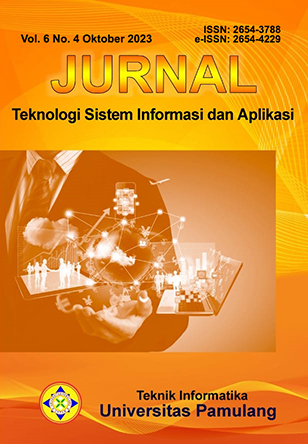Komparasi Metode Klasifikasi terhadap Data Penderita Penyakit Diabetes Menggunakan Python 3
Kata Kunci:
Classification, Comparison, Diabetes, Python 3, Naive Bayes, SVM (Support Vector Machine)Abstrak
Diabetes is a serious challenge in the world of health, with broad impacts. In an effort to overcome this problem, it is important to analyze the classification of diabetes data to provide valuable insights. This study focuses on the comparison of the two main classification methods, namely Naive Bayes and Support Vector Machine (SVM), in analyzing diabetes data. We use the Python 3 programming language for implementation. The initial study involved the characterization of the dataset, including parameters such as blood pressure and blood glucose levels, which were important factors in the analysis. The preprocessing process is carried out to ensure data quality by overcoming missing or invalid values. After that, the dataset is divided into training and testing subsets. The Naive Bayes and SVM methods are implemented using the scikit-learn library in Python 3. Both models are trained using a training subset and tested on a test subset. The test results show that both methods have good performance in classifying diabetes data, but SVM stands out with higher accuracy. SVM has the ability to handle complex data and find optimal decision boundaries. The Naive Bayes model achieves the highest accuracy of 78.13% on 70% training data and 30% testing data, while the SVM model achieves 79.63% on 90% training data and 10% testing data. Overall, this study provides an in-depth understanding of the effectiveness of both methods in the context of classifying data on diabetics.
Referensi
Alita, D., Fernando, Y., & Sulistiani, H. (2020). Implementasi Algoritma Multiclass Svm Pada Opini Publik Berbahasa Indonesia Di Twitter. Jurnal Tekno Kompak, 14(2), 86. https://doi.org/10.33365/jtk.v14i2.792
Annisa, R. (2019). Analisis Komparasi Algoritma Klasifikasi Data Mining Untuk Prediksi Penderita Penyakit Jantung. Jurnal Teknik Informatika Kaputama (JTIK), 3(1), 22–28. https://jurnal.kaputama.ac.id/index.php/JTIK/article/view/141/156
Annur, H. (2018). Klasifikasi Masyarakat Miskin Menggunakan Metode Naive Bayes. ILKOM Jurnal Ilmiah, 10(2), 160–165. https://doi.org/10.33096/ilkom.v10i2.303.160-165
Elfaladonna, F., & Rahmadani, A. (2019). Analisa Metode Classification-Decission Tree Dan Algoritma C.45 Untuk Memprediksi Penyakit Diabetes Dengan Menggunakan Aplikasi Rapid Miner. SINTECH (Science and Information Technology) Journal, 2(1), 10–17. https://doi.org/10.31598/sintechjournal.v2i1.293
Faid, M., Jasri, M., & Rahmawati, T. (2019). Perbandingan Kinerja Tool Data Mining Weka dan Rapidminer Dalam Algoritma Klasifikasi. Teknika, 8(1), 11–16. https://doi.org/10.34148/teknika.v8i1.95
Hana, F. M. (2020). Klasifikasi Penderita Penyakit Diabetes Menggunakan Algoritma Decision Tree C4.5. Jurnal SISKOM-KB (Sistem Komputer Dan Kecerdasan Buatan), 4(1), 32–39. https://doi.org/10.47970/siskom-kb.v4i1.173
Nurdiana, N., & Algifari, A. (2020). Studi Komparasi Algoritma Id3 Dan Algoritma Naive Bayes Untuk Klasifikasi Penyakit Diabetes Mellitus. Infotech Journal, 6(2), 18–23.
Putri, S., Irawan, E., & Rizky, F. (2021). Implementasi Data Mining Untuk Prediksi Penyakit Diabetes Dengan Algoritma C4.5. Januari, 2(1), 39–46.
Qisthiano, M. R., Ruswita, I., & Armilia, P. (2023). Implementasi Metode SVM dalam Analisis Sentimen Mengenai Vaksin dengan Menggunakan Python 3. 13(1), 1–7.
Saleh, A. (2015). Implementasi Metode Klasifikasi Naïve Bayes Dalam Memprediksi Besarnya Penggunaan Listrik Rumah Tangga. Journal of Informatics, Information System, Software Engineering and Applications (INISTA), 2(3). https://doi.org/10.20895/inista.v1i2.73
Trisno, I. B. (2016). Belajar Pemrograman Sulit ? Coba Python (Y. Hari (ed.)). Ubhara Manajemen Press.
Widodo, Y. B., Anggraeini, S. A., & Sutabri, T. (2021). Perancangan Sistem Pakar Diagnosis Penyakit Diabetes Berbasis Web Menggunakan Algoritma Naive Bayes. Jurnal Teknlogi Informatika Dan Komputer MH. Thamrin, 7(1), 112–123.
Unduhan
Diterbitkan
Cara Mengutip
Terbitan
Bagian
Lisensi
Hak Cipta (c) 2023 Ayu Okta Pratiwi, Tri Basuki Kurniawan, Edi Surya Negara, Yesi Novaria Kunang

Artikel ini berlisensi Creative Commons Attribution-NonCommercial 4.0 International License.
Authors who publish with this journal agree to the following terms:
- Authors retain copyright and grant the journal right of first publication with the work simultaneously licensed under a Creative Commons Attribution License that allows others to share the work with an acknowledgement of the work's authorship and initial publication in this journal.
- Authors are able to enter into separate, additional contractual arrangements for the non-exclusive distribution of the journal's published version of the work (e.g., post it to an institutional repository or publish it in a book), with an acknowledgement of its initial publication in this journal.
- Authors are permitted and encouraged to post their work online (e.g., in institutional repositories or on their website) prior to and during the submission process, as it can lead to productive exchanges, as well as earlier and greater citation of published work (See The Effect of Open Access).
Jurnal Teknologi Sistem Informasi dan Aplikasi have CC BY-NC or an equivalent license as the optimal license for the publication, distribution, use, and reuse of scholarly work.
In developing strategy and setting priorities, Jurnal Teknologi Sistem Informasi dan Aplikasi recognize that free access is better than priced access, libre access is better than free access, and libre under CC BY-NC or the equivalent is better than libre under more restrictive open licenses. We should achieve what we can when we can. We should not delay achieving free in order to achieve libre, and we should not stop with free when we can achieve libre.
This work is licensed under a Creative Commons Attribution-NonCommercial 4.0 International (CC BY-NC 4.0) License
YOU ARE FREE TO:
- Share - copy and redistribute the material in any medium or format
- Adapt - remix, transform, and build upon the material for any purpose, even commercially.
- The licensor cannot revoke these freedoms as long as you follow the license terms



_2020_-_7(2)_2024_-_Thumbnail.png)












